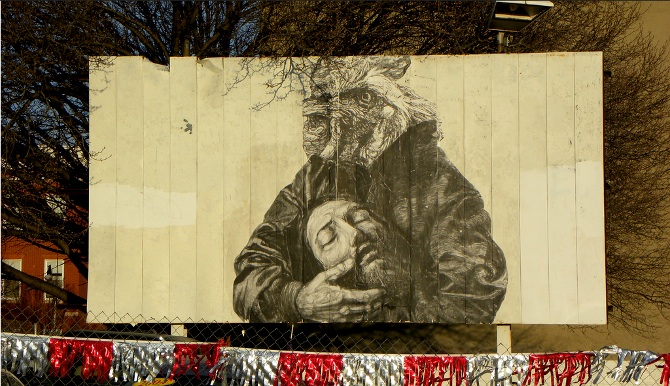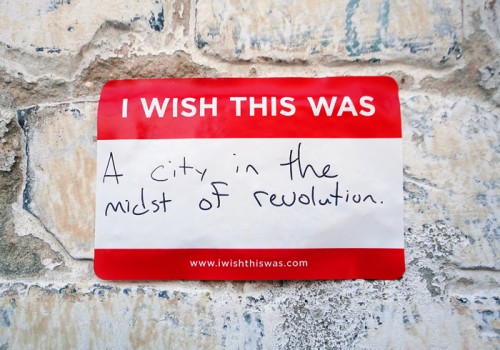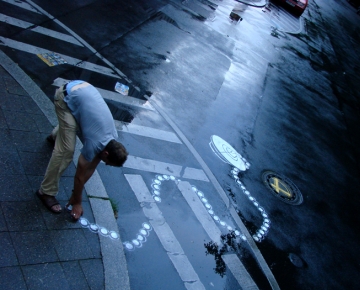 Photo: c/o Peter GibsonWhen Peter Gibson first set out with spray paint and stencils into the streets of Montreal, he had protest on his mind, not art. He had little sense that his small act of sabotage would usher him into the boundary-pushing realm of street art — or land him in the back of a police car, facing serious criminal charges.
Photo: c/o Peter GibsonWhen Peter Gibson first set out with spray paint and stencils into the streets of Montreal, he had protest on his mind, not art. He had little sense that his small act of sabotage would usher him into the boundary-pushing realm of street art — or land him in the back of a police car, facing serious criminal charges.
It was just after the terrorist attacks of September 11, 2001, and Gibson, a university-trained pianist who was 27 at the time, watched as the U.S. and its allies searched for an object on which to inflict their revenge. “Everybody was rattling sabers, getting ready to go to war,” he says. “But there was a disconnect between our way of life and consumerism — and oil in particular — and the effects that they were having around the world.”
For Gibson, the connections were clear: It was our passive acceptance of car culture that had gotten us into this mess. Had it not been for our addiction to oil, we wouldn’t have been meddling in the Middle East in the first place.
Searching for a way to express his frustration, Gibson turned to the pavement beneath his feet. He started by spray painting vigilante bike-route markers on city streets, inspired by a trick he’d seen in Adbusters (the anti-consumerist magazine that kicked off the current Wall-Street-directed mischief). It was his subtle way of making room for a less oil-dependent lifestyle.
Gibson’s art, he says, “evolved from there.”
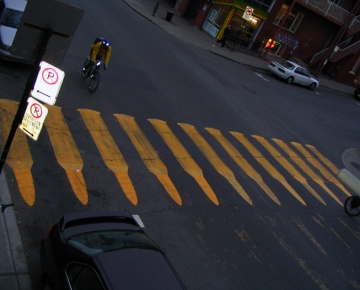 Photo: c/o Peter GibsonWorking under the moniker Roadsworth, he began to retrofit crosswalks with custom works of artistic protest. He morphed one into a giant boot print. “The idea was that pedestrians were taking over — this giant footprint taking back the streets,” he says. Elsewhere, he turned crosswalk bars into bullets, and interlaced others with barbed wire. “I was trying to make a connection between our lifestyle here and our use of oil and the wars that go on around the world,” he says.
Photo: c/o Peter GibsonWorking under the moniker Roadsworth, he began to retrofit crosswalks with custom works of artistic protest. He morphed one into a giant boot print. “The idea was that pedestrians were taking over — this giant footprint taking back the streets,” he says. Elsewhere, he turned crosswalk bars into bullets, and interlaced others with barbed wire. “I was trying to make a connection between our lifestyle here and our use of oil and the wars that go on around the world,” he says.
From these beginnings, Roadsworth’s work became more abstract — and more subversive. He began adding designs and flourishes to the lines on the streets just to mess with the accepted structure of the city. He stenciled flowers and windmills on the asphalt, along with his trademark “shadow demon,” which perched mischievously atop painted lines or street-sign shadows. “It was just like putting a mustache on the Mona Lisa,” he says. “I was challenging something that has this aura of authority to it. Tweaking those lines became a message in itself.”
The fun came to an abrupt end in the wee hours of November 29, 2004, when the police arrested Gibson while he was painting on the street, charging him with 85 counts of public mischief. The charges might sound like something out of a Monty Python skit, but this was serious business: Gibson faced jail time and hundreds of thousands of dollars in fines.
“It was pretty intense,” says Gibson. A local newspaper ran a story with the headline, “Roadsworth RIP.”
 Photo: c/o Peter GibsonThe case dragged on for more than a year, during which Gibson was under a loose form of house arrest, prohibited from leaving Montreal, yet confined to certain parts of the city. In the end, Gibson accepted what amounted to an out-of-court settlement. He admitted he was guilty, did 200 hours of community service, and spent two years on probation. In return, he avoided jail time and paid only about $250 in fines.
Photo: c/o Peter GibsonThe case dragged on for more than a year, during which Gibson was under a loose form of house arrest, prohibited from leaving Montreal, yet confined to certain parts of the city. In the end, Gibson accepted what amounted to an out-of-court settlement. He admitted he was guilty, did 200 hours of community service, and spent two years on probation. In return, he avoided jail time and paid only about $250 in fines.
Public support was key to his gentle handling, Gibson says today — and it didn’t hurt that the city itself had commissioned him to do a piece of legal art on a street even as it was prosecuting him for his illicit deeds. Apparently he had some admirers even in city government.
His anonymity lost, Gibson says he has stopped all street work in Montreal. “When I think of street art, for me, it’s an illegal art form by nature,” he says. While he may join an occasional bombing run in another town, he sticks to the rules when he’s home, making a living doing commissioned art and mural work. He’s just back from Northern Ireland, where he was working with school kids.
Meanwhile, the city of Montreal has improved its bike infrastructure, he says — and his guerilla bike route stunt has been repeated around the world by residents who are tired of the car being king. And Gibson doesn’t miss an opportunity to speak out about the oil-soaked culture that he believes is the root of much evil in the world. “It’s easy to point fingers, blame governments and corporations for the ills of the world,” he says, “but we all participate in it.”
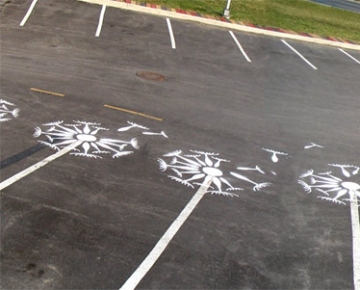 Photo: c/o Peter Gibson
Photo: c/o Peter Gibson
